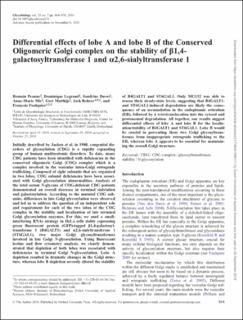Please use this identifier to cite or link to this item:
https://doi.org/10.21256/zhaw-3989Full metadata record
| DC Field | Value | Language |
|---|---|---|
| dc.contributor.author | Peanne, Romain | - |
| dc.contributor.author | Legrand, Dominique | - |
| dc.contributor.author | Duvet, Sandrine | - |
| dc.contributor.author | Mir, Anne-Marie | - |
| dc.contributor.author | Matthijs, Gert | - |
| dc.contributor.author | Rohrer, Jack | - |
| dc.contributor.author | Foulquier, Francois | - |
| dc.date.accessioned | 2018-06-13T08:54:33Z | - |
| dc.date.available | 2018-06-13T08:54:33Z | - |
| dc.date.issued | 2011-11-08 | - |
| dc.identifier.issn | 0959-6658 | de_CH |
| dc.identifier.issn | 1460-2423 | de_CH |
| dc.identifier.uri | https://digitalcollection.zhaw.ch/handle/11475/6816 | - |
| dc.description | Erworben im Rahmen der Schweizer Nationallizenzen (http://www.nationallizenzen.ch) | de_CH |
| dc.description.abstract | Initially described by Jaeken et al. in 1980, congenital disorders of glycosylation (CDG) is a rapidly expanding group of human multisystemic disorders. To date, many CDG patients have been identified with deficiencies in the conserved oligomeric Golgi (COG) complex which is a complex involved in the vesicular intra-Golgi retrograde trafficking. Composed of eight subunits that are organized in two lobes, COG subunit deficiencies have been associated with Golgi glycosylation abnormalities. Analysis of the total serum N-glycans of COG-deficient CDG patients demonstrated an overall decrease in terminal sialylation and galactosylation. According to the mutated COG subunits, differences in late Golgi glycosylation were observed and led us to address the question of an independent role and requirement for each of the two lobes of the COG complex in the stability and localization of late terminal Golgi glycosylation enzymes. For this, we used a small-interfering RNAs strategy in HeLa cells stably expressing green fluorescent protein (GFP)-tagged β1,4-galactosyltransferase 1 (B4GALT1) and α2,6-sialyltransferase 1 (ST6GAL1), two major Golgi glycosyltransferases involved in late Golgi N-glycosylation. Using fluorescent lectins and flow cytometry analysis, we clearly demonstrated that depletion of both lobes was associated with deficiencies in terminal Golgi N-glycosylation. Lobe A depletion resulted in dramatic changes in the Golgi structure, whereas lobe B depletion severely altered the stability of B4GALT1 and ST6GAL1. Only MG132 was able to rescue their steady-state levels, suggesting that B4GALT1- and ST6GAL1-induced degradation are likely the consequence of an accumulation in the endoplasmic reticulum (ER), followed by a retrotranslocation into the cytosol and proteasomal degradation. All together, our results suggest differential effects of lobe A and lobe B for the localization/stability of B4GALT1 and ST6GAL1. Lobe B would be crucial in preventing these two Golgi glycosyltransferases from inappropriate retrograde trafficking to the ER, whereas lobe A appears to be essential for maintaining the overall Golgi structure. | de_CH |
| dc.language.iso | en | de_CH |
| dc.publisher | Oxford University Press | de_CH |
| dc.relation.ispartof | Glycobiology | de_CH |
| dc.rights | Licence according to publishing contract | de_CH |
| dc.subject.ddc | 572: Biochemie | de_CH |
| dc.title | Differential effects of lobe A and lobe B of the conserved oligomeric golgi complex on the stability of β1,4-galactosyltransferase 1 and α2,6-sialyltransferase 1 | de_CH |
| dc.type | Beitrag in wissenschaftlicher Zeitschrift | de_CH |
| dcterms.type | Text | de_CH |
| zhaw.departement | Life Sciences und Facility Management | de_CH |
| zhaw.organisationalunit | Institut für Chemie und Biotechnologie (ICBT) | de_CH |
| dc.identifier.doi | 10.21256/zhaw-3989 | - |
| dc.identifier.doi | 10.1093/glycob/cwq176 | de_CH |
| zhaw.funding.eu | No | de_CH |
| zhaw.issue | 7 | de_CH |
| zhaw.originated.zhaw | Yes | de_CH |
| zhaw.pages.end | 876 | de_CH |
| zhaw.pages.start | 864 | de_CH |
| zhaw.publication.status | publishedVersion | de_CH |
| zhaw.volume | 21 | de_CH |
| zhaw.publication.review | Peer review (Publikation) | de_CH |
| zhaw.webfeed | Zellphysiologie | de_CH |
| Appears in collections: | Publikationen Life Sciences und Facility Management | |
Files in This Item:
| File | Description | Size | Format | |
|---|---|---|---|---|
| cwq176.pdf | 674.59 kB | Adobe PDF |  View/Open |
Show simple item record
Peanne, R., Legrand, D., Duvet, S., Mir, A.-M., Matthijs, G., Rohrer, J., & Foulquier, F. (2011). Differential effects of lobe A and lobe B of the conserved oligomeric golgi complex on the stability of β1,4-galactosyltransferase 1 and α2,6-sialyltransferase 1. Glycobiology, 21(7), 864–876. https://doi.org/10.21256/zhaw-3989
Peanne, R. et al. (2011) ‘Differential effects of lobe A and lobe B of the conserved oligomeric golgi complex on the stability of β1,4-galactosyltransferase 1 and α2,6-sialyltransferase 1’, Glycobiology, 21(7), pp. 864–876. Available at: https://doi.org/10.21256/zhaw-3989.
R. Peanne et al., “Differential effects of lobe A and lobe B of the conserved oligomeric golgi complex on the stability of β1,4-galactosyltransferase 1 and α2,6-sialyltransferase 1,” Glycobiology, vol. 21, no. 7, pp. 864–876, Nov. 2011, doi: 10.21256/zhaw-3989.
PEANNE, Romain, Dominique LEGRAND, Sandrine DUVET, Anne-Marie MIR, Gert MATTHIJS, Jack ROHRER und Francois FOULQUIER, 2011. Differential effects of lobe A and lobe B of the conserved oligomeric golgi complex on the stability of β1,4-galactosyltransferase 1 and α2,6-sialyltransferase 1. Glycobiology. 8 November 2011. Bd. 21, Nr. 7, S. 864–876. DOI 10.21256/zhaw-3989
Peanne, Romain, Dominique Legrand, Sandrine Duvet, Anne-Marie Mir, Gert Matthijs, Jack Rohrer, and Francois Foulquier. 2011. “Differential Effects of Lobe A and Lobe B of the Conserved Oligomeric Golgi Complex on the Stability of Β1,4-Galactosyltransferase 1 and Α2,6-Sialyltransferase 1.” Glycobiology 21 (7): 864–76. https://doi.org/10.21256/zhaw-3989.
Peanne, Romain, et al. “Differential Effects of Lobe A and Lobe B of the Conserved Oligomeric Golgi Complex on the Stability of Β1,4-Galactosyltransferase 1 and Α2,6-Sialyltransferase 1.” Glycobiology, vol. 21, no. 7, Nov. 2011, pp. 864–76, https://doi.org/10.21256/zhaw-3989.
Items in DSpace are protected by copyright, with all rights reserved, unless otherwise indicated.